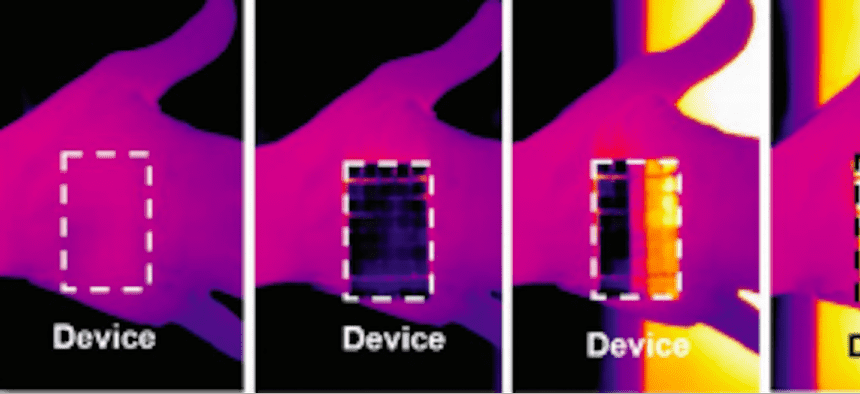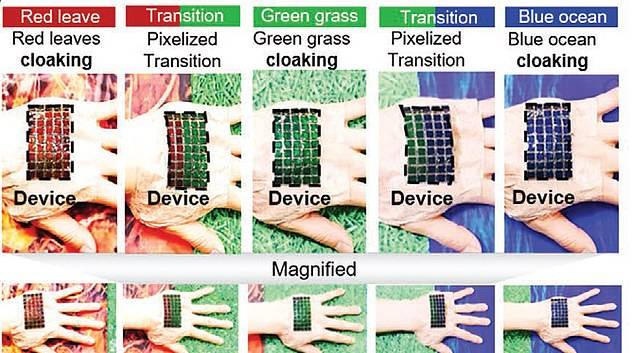
Multispectral cloaking in the visible and IR regimes. Image: Dr. Seung Hwan Ko
A team of researchers in South Korea recently published a paper entitled, “Thermally Controlled, Active Imperceptible Artificial Skin in Visible-to-Infrared Range.” Led by Dr. Seung Hwan Ko out of Seoul National University, the research centers around a cloaking “skin,” which consists of small patches that use heating and cooling to mimic either thermal characteristics or visible colors of any given environment. With this technology progressing, it could be implemented in many different industries. But for the military, it could completely change the entire landscape of modern warfare, and effectively make soldiers invisible.
BACKGROUND: Invisible Soldiers Are Not A New Idea
The idea for this research originated when Dr. Seung Hwan Ko noticed cloaking abilities in movies. He told The Debrief that, “Invisible cloak or skin is the frequently occurring theme in the science fiction movies or fantasy novels such as Predator or the Harry Potter series.” But it didn’t end there. Dr. Ko was inspired by marine life as well. “Cephalopods can change their body colors and camouflage into the environment by stimulating their muscle to control the reflectance of their body surface depending on their will. Yet, human skin, on the other hand, does not exhibit such a trait despite the outstanding tactile senses and versatile functionalities.” This is what prompted Dr. Ko to attempt to mimic these properties so that human beings can also acquire these capabilities.

Dr. Seung Hwan Ko (Image: Seoul National University)
ANALYSIS: How to Create an Invisible Soldier?
Dr. Ko and his research team are hard at work on this “artificial skin.” According to the paper, the patches that make up the “skin” are built up of “pixels” that contain thermochromic liquid crystals. These crystals can change color depending on temperature. According to the paper, this allows “the generation of a diverse number of colors by controlling temperature. The cloaking in the visible range is therefore achieved separately by matching the ambient color.”
Expanding on their ideas and concepts, Dr. Ko and his team have demonstrated the technology by putting these patches on a human hand and moved it from one end of a color/temperature spectrum to the other. In the paper, Ko explains that, “As the hand moves across different backgrounds, each pixel sequentially switches its color/temperature based on their relative positions.” For military-specific demonstration, the patches were placed on a human’s cheek and they took cover in a background of bushes. The patched area of the skin matches the background and appears to look identical to the camouflage-patterned military uniforms.

The background in the visible spectrum consists of red maple leaves, green grass, and deep blue ocean… Note that each device pixel can autonomously express different colors/temperatures based on its relative positions as the hand moves across various backgrounds owing to the pixelization of the device. (Image: Dr. Seung Hwan Ko)
OUTLOOK: “I Can See You. Can You See Me?”
Dr. Ko and his team are very excited for the future of this research. Currently, he and the team are looking at ways to integrate thermal insulators to the skin so that it can work properly in extreme weather conditions. “For the artificial camouflage skin to be implemented in a number of industries,” Dr. Ko tells The Debrief, “much effort must be devoted to increase the energy storage capabilities of batteries since this skin consumes energy and soldiers are more likely to be engaged in covert military missions at the remote area for a long period of time.”
While this cloaking technology would be quite advantageous to the military, Dr. Ko explained that this isn’t the only industry where he hopes it will be implemented. “We believe that this technology could be used for android robots, so that they can change color of their bodies for a suitable purpose, or emit heat just like human beings just by switching temperatures. Perhaps they could even exchange heat with human beings when necessary.”
Ryan Sprague
No comments:
Post a Comment
Note: Only a member of this blog may post a comment.